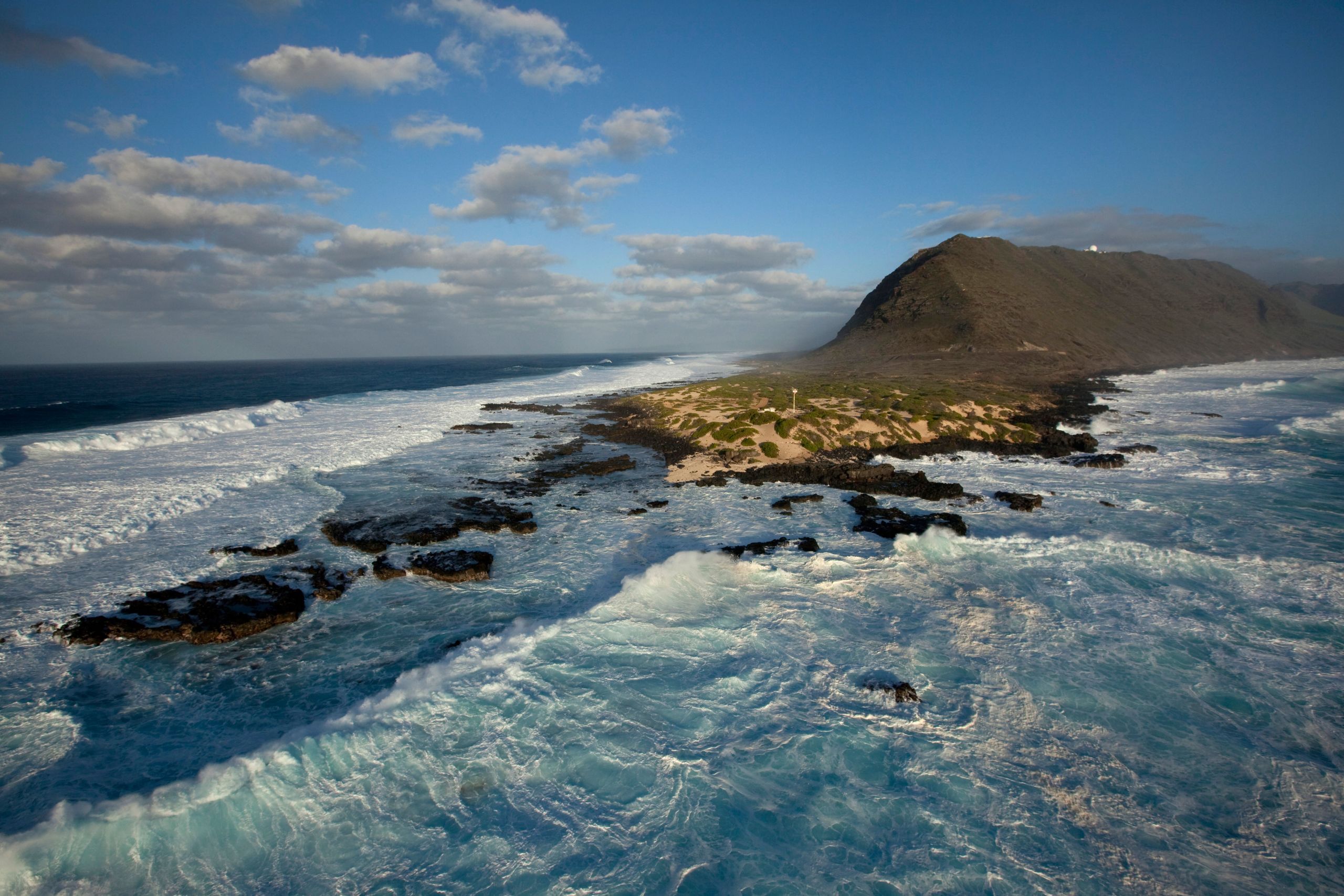Louis Aila
Ka Lae o Kaʻena Medley

Mānaleo Series
These short clips of native speakers on Ka Leo Hawaiʻi talking about their lives and practices are invaluable windows into our past, our language, and ourselves. Our mahalo kūhohonu goes out to Larry Kimura and Puakea Nogelmeier for their foresight in preserving the voices of these hulu kupuna.
Listen and read along:
1. Press play on the video below (ensure volume is up).
2. Scroll down and read along in the language of your choice.
3. Repeat as needed.
*Mobile users: Touch the video two times for the button on the upper left and minimize the window to listen and read at the same time.
Louis Aila with a medley for his ʻāina hānau
LK: ʻAe e Pāpā, e aloha aku ana ʻoe i nā poʻe Hawaiʻi i kēia ahiahi me kekahi mele paha?
LA: ʻAe!
LK: Ma mua nō o kā kāua walawalaʻau ʻana.
LA: ʻO kaʻu hīmeni mua i kēia pō e pili ana no koʻu ʻāina mai ka lae ʻo Kaʻena, a ka pahuhopu i lalo o Waialua, Oʻahu nei. I koʻu mau lā ʻōpiopio, lohe wau i koʻu poʻe kaikuaʻana, nā poʻe oʻo, ka poʻe e hīmeni i kēia mau hīmeni, mai Ka Lae ʻo Kaʻena, a hoʻi i Kawaihāpai a i Waialua. ʻEkolu kēia poʻe hīmeni, ʻoiai e hīmeni mua ana au i ka hīmeni ʻo Ka Lae ʻo Kaʻena, pau, a Kawaikumuʻole, ʻo ia hoʻi, he ana kēia ma hope iho o ka pali o Kawaihāpai, he ana kēia a mākou e hoʻokomo mau ai i ko mākou manawa kamaliʻi, piʻi mau ana mākou i loko o kēia ana, a hoʻoipoipo mau ana mākou i loko o kēia ana, he wahi pōhaku, kohu mea, ua hoʻonohonoho ʻia nō paha i laila mai ke au kahiko mai...
LK: ʻĒ.
LA: A, ʻo ka wai, puka maila mai ka pōhaku mai, ʻaʻole hiki iā ʻoe ke ʻike, mai hea lā mai kēia wai e puka mai ai. A ʻo ia ka mea e kapa ʻia ai i kēlā wahi ʻo Kawaikumuʻole. A, pau, hōʻea au i Ka ʻEhu Kai o Puaʻena. A ʻo ia ka palena pau o kaʻu hīmeni.
LK: ʻAe, mahalo.
Ka lae ʻo Kaʻena, e hui ai kāua
Ke aloha welawela, kou aloha i oʻu nei
A eia hoʻi au, kou lei onaona
I hoa pili no ka ʻāina malihini
I hoa pili no ka ʻāina malihini
Nani nā hono o Kawaikumuʻole
Kū kilakila lā i ka ʻōpua
ʻO kuʻu pua lehua kau mai i luna
A ʻo ka hene waiʻolu lana mālie
A ʻo ka hene waiʻolu lana mālie
Aia i Waialua, maʻemaʻe ke ʻike aku
Ke ʻehu kai o Puaʻena me ke one o Māeaea
Aia i Waialua, maʻemaʻe ke ʻike aku
Ke ʻehukai o Puaʻena me ke one o Māeaea
LK: Mahalo nui i kēia mele kahiko o ka ʻāina.
Unuhina - Translation
LK: So, Papa, are you going to greet the people of Hawaiʻi this evening with a song?
LA: Yes!
LK: Before we talk story.
LA: My first song this evening is about my home from Kaʻena point, the furthest point here in Oʻahu. In my childhood, I heard my elders, people older than me, who sang these songs from Kaʻena point, to Kawaihāpai, then on to Waialua. There are three songs, because I am going to first sing the song Ka Lae ʻO Kaʻena, then Kawaikumuʻole, and this cave, behind the Kawaihāpai cliff, this was a cave that we would enter in our childhood, and we would always climb into this cave and get up to romantic stuff in there. Inside this cave, there is this stone, and it’s as if it was set up there from the ancient times...
LK: Yeah.
LA: And, the water, it comes from the stone, you can’t see where this water comes from. And so that is the reason this place is called Kawaikumuʻole (water without a source). After that, I come to the song Ka ʻEhu Kai o Puaʻena. And that is the last of my songs.
LK: Yes. Mahalo.
Kaʻena Point is where we meet
Your love is scorching hot to me
Here I am, your fragrant lei
Your intimate companion in this new land
The cliffs of the Kawaikumuʻole bays are beautiful
Standing majestic against the clouds
My lehua blossom placed above
Atop the gentle slope in the calm
There in Waialua, perfection to behold
The sea spray of Puaʻena and the sands of Māeaea
There in Waialua, perfection to behold
The sea spray of Puaʻena and the sands of Māeaea
He manaʻo na Kaliko
Louis Aila is a native of the northwestern edges of Oʻahu. The songs that he shares with the Ka Leo Hawaiʻi audience demonstrate his personal connection to these places he mentions in verse. Aila teaches us that mele carry moʻolelo or stories of ʻāina within them. Aila geographically situates his audience and introduces us to his ʻāina. He starts with the furthest point of his ʻāina, Kaʻena point, which is accessible via Mokulēʻia. He then transitions to Kawaikumuʻole and describes the majestic cliffs that are nestled below Kaʻala, the pinnacle of Oʻahu. Then he takes us down through the lands of Waialua which are Puaʻena and Māeaea.
The penultimate verse of Aila’s song is a lesson for all. Puaʻena and Māeaea are now conflated into what is now known today as Haleʻiwa. Puaʻena is known to many surfers. But Māeaea has unfortunately slipped out of memory. Māeaea is now where Haleʻiwa town and Haleʻiwa beach park stands today. Mele hold memory. Aila’s childhood story showcases the connection that his mele are in fact reminders of the moʻolelo of his ʻāina.
Na Kalikoaloha Martin i palapala, unuhi, a kākau
Na Hina Kneubuhl i hoʻoponopono a hoʻonohonoho
Click here to access the full recording on Kaniʻāina.
